
Trophallaxis is the transfer of food or other fluids among members of a community through mouth-to-mouth (stomodeal) or anus-to-mouth (proctodeal) feeding. Along with nutrients, trophallaxis can involve the transfer of molecules such as pheromones, organisms such as symbionts, and information to serve as a form of communication. Trophallaxis is used by some birds, gray wolves, vampire bats, and is most highly developed in eusocial insects such as ants, wasps, bees, and termites.

Tetramorium atratulum is a rare workerless socially parasitic ant from the Palaearctic region, which has even been introduced together with its host in North America. This extreme inquiline is represented only by female and pupoid type male individuals, whose morphology and anatomy indicate a highly specialized level of parasitism. The body of males is depigmentated, the cuticle is thin, the petiole and postpetiole are widely connected, and degenerate mandibles, palps, and antennae are observed. Female wing venation is reduced and the occipital region is narrowed. Mature females are typically physogastric and found in queenless host nests.

Carpenter ants are large ants indigenous to many forested parts of the world.
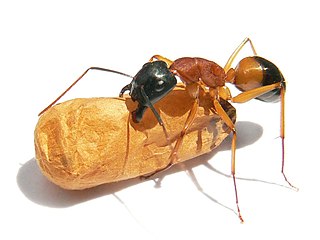
The banded sugar ant, also known as the sugar ant, is a species of ant native to Australia. A member of the genus Camponotus in the subfamily Formicinae, it was described by German entomologist Wilhelm Ferdinand Erichson in 1842. Its common name refers to the ant's liking for sugar and sweet food, as well as the distinctive orange-brown band that wraps around its gaster.

The black carpenter ant is one of the largest and most common species of carpenter ant native to the central and eastern United States as well as eastern Canada.

Camponotus vagus is a species of large, black, Palaearctic carpenter ant with a wide range that includes much of Europe, a large area of Asia, and part of Africa.

Camponotus atriceps, previously referred as C. abdominalis, is a species of carpenter ant, endemic to the Americas.
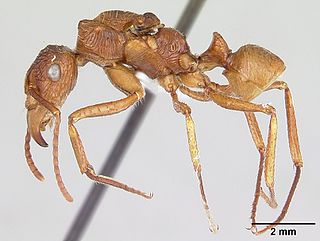
Ectatomma parasiticum is a species of ant in the subfamily Ectatomminae. Known from Mexico, the species is a social parasite of the related species Ectatomma tuberculatum. It is the only parasitic species described in the Ectatomminae subfamily, and among the rare inquilines from the tropics.
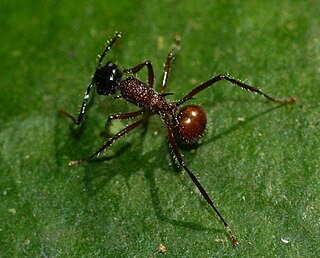
Polyrhachis is a genus of formicine ants found in the Old World with over 600 species. The genus is yet to be comprehensively resolved and contains many varied species including nest-weavers, swimming workers, soil and tree-dwellers. First fossil record of this genus was P. annosa from Miocene.

Camponotus japonicus, commonly known as the Japanese carpenter ant, is a species of ant native to eastern Asia. It is black, and one of the largest ants. A nest has about ten to thousands of individuals, and it can be a pest when it enters households or protects aphids. There are several subspecies of this ant in different areas of Asia, with the largest of the species being located in northern China.
Camponotus bishamon is a species of carpenter ant endemic to Japan.

The black-headed sugar ant, also known as the brown sugar ant, is a species of Formicinae ant endemic to Australia. Found throughout most states, the species is a member of the genus Camponotus, a cosmopolitan genus of ants commonly known as carpenter ants. It was formally described and named by British entomologist Frederick Smith in 1858. These ants are characterised by their black head, reddish-brown mesosoma and black gaster, which can change in colour.
Ophiocordyceps camponoti-rufipedis is a species of fungus that parasitizes insect hosts, in particular members of the order Hymenoptera. It was first isolated from Viçosa, Minas Gerais, at an altitude of 700 metres (2,300 ft) on Camponotus rufipes.
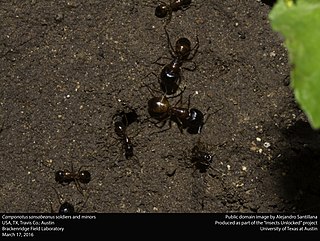
Camponotus sansabeanus is a species of carpenter ant native to the western United States, northern Mexico, Missouri, Arkansas, and Louisiana.
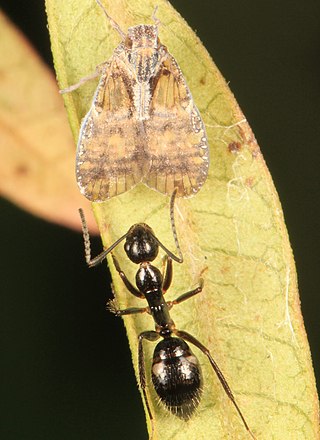
Camponotus sexguttatus is a species of carpenter ant native to South America, Central America, Mexico, and the Caribbean. This species is invasive in Florida, Hawaii, and Arizona.
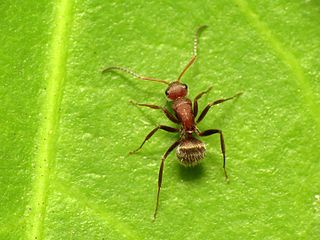
Camponotus planatus, known generally as the compact carpenter ant or short carpenter ant, is one of three Camponotus species that is polygynous, or has more than one queen. It is a species of ant.

Camponotus chromaiodes, known generally as, the ferruginous carpenter ant or red carpenter ant, is a species of carpenter ant native to the eastern United States, Nebraska, Kansas, and possibly California. Acetobacteraceae are found in the guts of workers in this species.
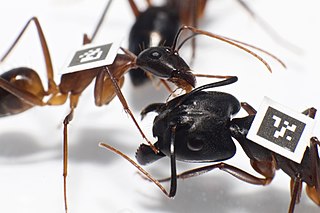
Camponotus fellah is a species of carpenter ant found across the Middle East and North Africa. This species was formally described by Dalla Torre in 1893. A C. fellah queen holds the record for Israeli ant longevity, surviving for 26 years (1983-2009) in a laboratory environment.
Dendromyrmex is a subgenus of carpenter ants.

Camponotus microps is a species of carpenter ant native to Arizona, New Mexico, Sonora, Queretaro, and Guanajuato. This species was separated from the Camponotus festinatus complex in 2006 by Roy Snelling.


















